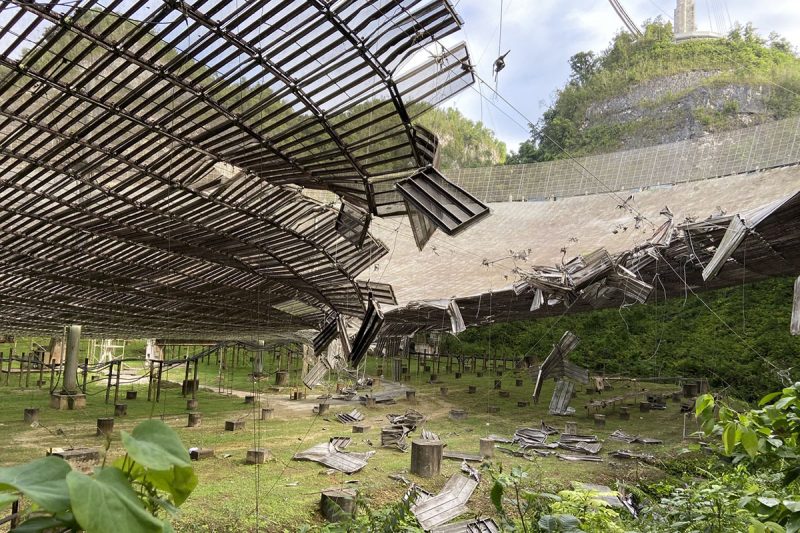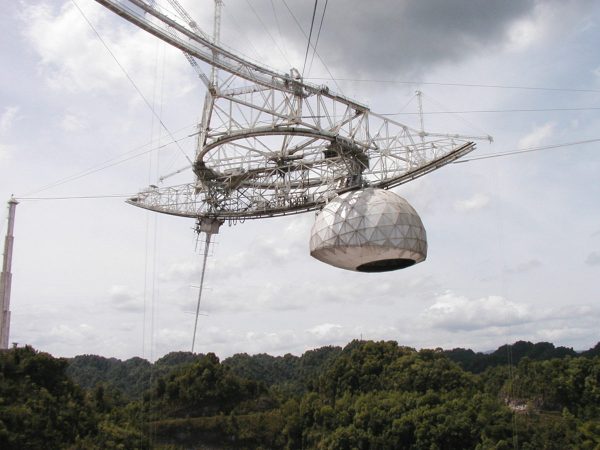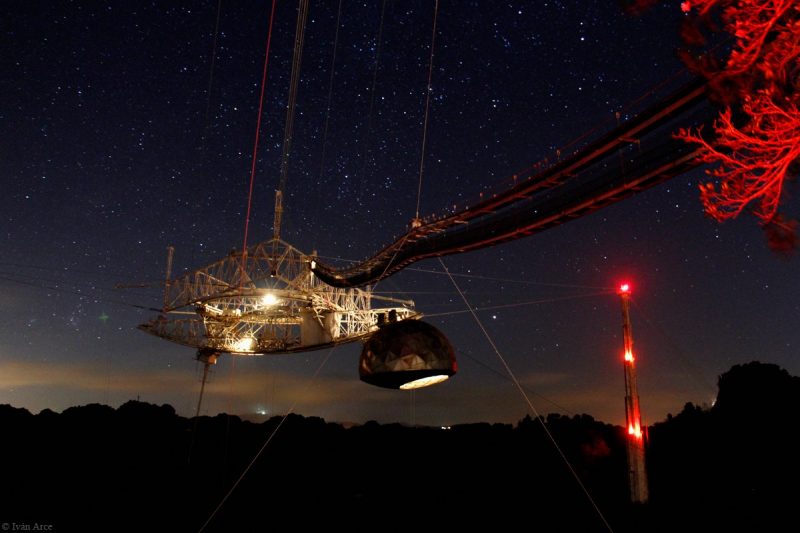

Some of the damages caused by a broken supporting cable on the 1,000-foot (305 m) Arecibo radio dish. The cable broke on Monday, August 10. Image via University of Central Florida.
One of the auxiliary cables that helps support the receiver platform in place above the famous Arecibo Observatory in Puerto Rico broke on Monday, August 10, 2020, causing a 100-foot-long (30-meter-long) gash on the southeast side of the 1,000-foot (305-meter) reflector dish.
According to the University of Central Florida (UFC), which manages the National Science Foundation facility, the three-inch cable also damaged about six to eight panels in the Gregorian Dome, an antenna receiver on the platform. It is not yet clear what caused the cable to break.
There are 18 cables, running from three reinforced concrete towers, which support the 900-ton platform above the dish. The facility is now closed while engineers review the damage and assess the extent of repairs that will be needed to bring the telescope back online. Francisco Cordova, the director of the observatory, said:
We have a team of experts assessing the situation. Our focus is assuring the safety of our staff, protecting the facilities and equipment, and restoring the facility to full operations as soon as possible, so it can continue to assist scientists around the world.

The Gregorian Dome above the big radio dish at the Arecibo Observatory. The cable accident – which caused a gash in the disk itself – also damaged about 6 to 8 panels in this dome. Image via the Planetary Society.
You’ve likely seen photos – or a movie, or played a video game – featuring Arecibo Observatory’s radio telescope. It was the world’s largest single-aperture telescope from its completion in 1963 until July 2016, when China completed its Five-Hundred-Meter Aperture Spherical Telescope (FAST). Still, the big radio telescope at Arecibo – built into a natural depression in the landscape of a Caribbean island – is used for professional research not just in radio astronomy, but also for radar and atmospheric studies. And, in recent years, as multiple hurricanes have swept across the Caribbean, including Hurricanes Irma and Maria in 2017, it’s been more of a struggle to keep the telescope in good repair. That is why, in late 2019, the U.S. Congress supported emergency supplemental funds for the site. The new funds ($12.3 million, to be used over four years) represented an investment in Arecibo’s future.
The new damage to Arecibo, caused by the heavy cable, happened while repairs from Hurricane Maria (2017) were still ongoing.

A wide view of the Arecibo radio dish, prior to the damage. Image via Arecibo Observatory.
Among other discoveries made at Arecibo Observatory, the first planets beyond our solar system – now called exoplanets – were found from there in 1990 by astronomer Aleksander Wolszczan; the planets orbit the pulsar PSR B1257+12.
Among many contributions to science, the facility helps in the analysis of Near-Earth Objects, playing an important role in defending our planet from asteroid strikes.

The Gregorian Dome and metal platform are visible in this beautiful image captured during a star party at the Arecibo Observatory. Image by Ivan Arce.
Bottom line: The famous Arecibo Observatory in Puerto Rico underwent damage on Monday, August 10, 2020, when one of the auxiliary cables that helps support the receiver platform in place above the large radio dish broke, causing a 100-foot-long (30-meter-long) gash on the southeast side of the dish.
from EarthSky https://ift.tt/3izo7SV


Some of the damages caused by a broken supporting cable on the 1,000-foot (305 m) Arecibo radio dish. The cable broke on Monday, August 10. Image via University of Central Florida.
One of the auxiliary cables that helps support the receiver platform in place above the famous Arecibo Observatory in Puerto Rico broke on Monday, August 10, 2020, causing a 100-foot-long (30-meter-long) gash on the southeast side of the 1,000-foot (305-meter) reflector dish.
According to the University of Central Florida (UFC), which manages the National Science Foundation facility, the three-inch cable also damaged about six to eight panels in the Gregorian Dome, an antenna receiver on the platform. It is not yet clear what caused the cable to break.
There are 18 cables, running from three reinforced concrete towers, which support the 900-ton platform above the dish. The facility is now closed while engineers review the damage and assess the extent of repairs that will be needed to bring the telescope back online. Francisco Cordova, the director of the observatory, said:
We have a team of experts assessing the situation. Our focus is assuring the safety of our staff, protecting the facilities and equipment, and restoring the facility to full operations as soon as possible, so it can continue to assist scientists around the world.

The Gregorian Dome above the big radio dish at the Arecibo Observatory. The cable accident – which caused a gash in the disk itself – also damaged about 6 to 8 panels in this dome. Image via the Planetary Society.
You’ve likely seen photos – or a movie, or played a video game – featuring Arecibo Observatory’s radio telescope. It was the world’s largest single-aperture telescope from its completion in 1963 until July 2016, when China completed its Five-Hundred-Meter Aperture Spherical Telescope (FAST). Still, the big radio telescope at Arecibo – built into a natural depression in the landscape of a Caribbean island – is used for professional research not just in radio astronomy, but also for radar and atmospheric studies. And, in recent years, as multiple hurricanes have swept across the Caribbean, including Hurricanes Irma and Maria in 2017, it’s been more of a struggle to keep the telescope in good repair. That is why, in late 2019, the U.S. Congress supported emergency supplemental funds for the site. The new funds ($12.3 million, to be used over four years) represented an investment in Arecibo’s future.
The new damage to Arecibo, caused by the heavy cable, happened while repairs from Hurricane Maria (2017) were still ongoing.

A wide view of the Arecibo radio dish, prior to the damage. Image via Arecibo Observatory.
Among other discoveries made at Arecibo Observatory, the first planets beyond our solar system – now called exoplanets – were found from there in 1990 by astronomer Aleksander Wolszczan; the planets orbit the pulsar PSR B1257+12.
Among many contributions to science, the facility helps in the analysis of Near-Earth Objects, playing an important role in defending our planet from asteroid strikes.

The Gregorian Dome and metal platform are visible in this beautiful image captured during a star party at the Arecibo Observatory. Image by Ivan Arce.
Bottom line: The famous Arecibo Observatory in Puerto Rico underwent damage on Monday, August 10, 2020, when one of the auxiliary cables that helps support the receiver platform in place above the large radio dish broke, causing a 100-foot-long (30-meter-long) gash on the southeast side of the dish.
from EarthSky https://ift.tt/3izo7SV

Aucun commentaire:
Enregistrer un commentaire